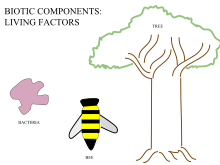Biotic component
Biotic components, or biotic factors, can be described as any living component that affects another organism or shapes the ecosystem. This includes both animals that consume other organisms within their ecosystem, and the organism that is being consumed. Biotic factors also include human influence, pathogens, and disease outbreaks. Each biotic factor needs the proper amount of energy and nutrition to function day to day.

Biotic components are typically sorted into three main categories:
- Producers, otherwise known as autotrophs, convert energy (through the process of photosynthesis) into food.
- Consumers, otherwise known as heterotrophs, depend upon producers (and occasionally other consumers) for food.
- Decomposers, otherwise known as detritivores, break down chemicals from producers and consumers (usually antibiotic) into simpler form which can be reused.
Influences
Species
Nearly all species are influenced by biotic factors in one way or another. If the number of predators was to increase, the entire food chain would be affected as any prey falling below that specified predator in the food chain will become prey. If the prey is not given enough time by the predator to repopulate, this could not only cause endangerment and extinction in the prey, but the predator as well. Contradicting a decrease in population size, if a particular species reproduces too rapidly, this will cause an increase in population size, thus affecting the environment around them.
Pathogens and Disease Outbreaks
When disease outbreaks occur, it can be detrimental to an ecosystem. When a disease hits, it will usually affect more than one species, thus causing a serious outbreak. This has the potential to set off a chain reaction thus, causing endangerment to a variety of species within that ecosystem.
Human Contact
Humans make the most sudden and long-term changes in an environment (e.g. pollution and waste). These changes either drive species out of their territory or force them to adapt to their new surroundings. These changes have the largest impact on an ecosystems population size, typically causing a serious decrease.
References
- Notes